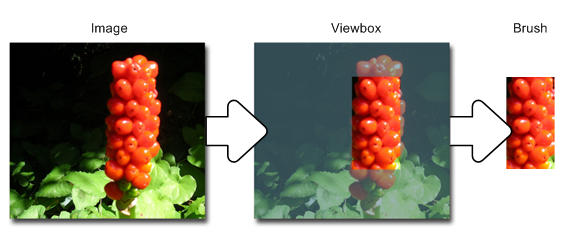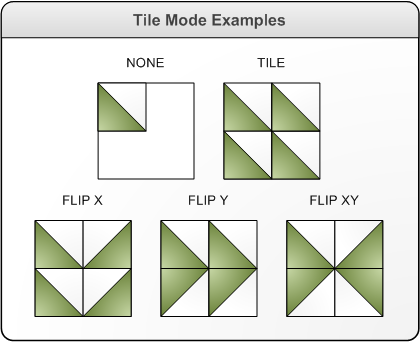IXpsOMTileBrush interface (xpsobjectmodel.h)
A tile brush uses a visual image to paint a region by repeating the image.
This is the base interface of IXpsOMImageBrush and IXpsOMVisualBrush.
Inheritance
The IXpsOMTileBrush interface inherits from IXpsOMBrush. IXpsOMTileBrush also has these types of members:
Methods
The IXpsOMTileBrush interface has these methods.
| IXpsOMTileBrush::GetTileMode Gets the XPS_TILE_MODE value that describes the tile mode of the brush. |
| IXpsOMTileBrush::GetTransform Gets a pointer to the IXpsOMMatrixTransform interface that contains the resolved matrix transform for the brush. (IXpsOMTileBrush.GetTransform) |
| IXpsOMTileBrush::GetTransformLocal Gets a pointer to the IXpsOMMatrixTransform interface that contains the local, unshared resolved matrix transform for the brush. |
| IXpsOMTileBrush::GetTransformLookup Gets the lookup key that identifies the IXpsOMMatrixTransform interface in a resource dictionary that contains the resolved matrix transform for the brush. |
| IXpsOMTileBrush::GetViewbox Gets the portion of the source image to be used by the tile. |
| IXpsOMTileBrush::GetViewport Gets the portion of the destination geometry that is covered by a single tile. |
| IXpsOMTileBrush::SetTileMode Sets the XPS_TILE_MODE value that describes the tiling mode of the brush. |
| IXpsOMTileBrush::SetTransformLocal Sets the IXpsOMMatrixTransform interface pointer to a local, unshared matrix transform. |
| IXpsOMTileBrush::SetTransformLookup Sets the lookup key name of a shared matrix transform that will be used as the transform for this brush. |
| IXpsOMTileBrush::SetViewbox Sets the portion of the source content to be used as the tile image. |
| IXpsOMTileBrush::SetViewport Sets the portion of the destination geometry that is covered by a single tile. |
Remarks
As shown in the illustration that follows, the tile brush takes a visual element, or a part of it, transforms the visual element to create a tile, places the tile in the viewport of the output area, and fills the output area as specified by the tile mode.
 In the preceding illustration, the viewport is the area covered by the first tile in the output area. The viewport image is repeated throughout the output area as specified by the tile mode. The transform property determines how the output area is transformed after the viewport has been tiled in the output area. The part of the output area that is ultimately rendered as a visible image is determined by the path, stroke, or glyph that is using the tile brush.
In the preceding illustration, the viewport is the area covered by the first tile in the output area. The viewport image is repeated throughout the output area as specified by the tile mode. The transform property determines how the output area is transformed after the viewport has been tiled in the output area. The part of the output area that is ultimately rendered as a visible image is determined by the path, stroke, or glyph that is using the tile brush.
A viewbox describes the portion of the source image that is used for the brush. The viewbox in the preceding illustration has the same size as the source image, so all of the source image is used for the brush. A viewbox can also be smaller than the original image.
In the illustration that follows, the brush is created by using a viewbox that includes only a portion of the original image or visual.
 The next illustration shows the tile modes that are used to repeat the tile image to fill the output area. If the tile mode value is XPS_TILE_MODE_NONE, the tile image is drawn only once.
The next illustration shows the tile modes that are used to repeat the tile image to fill the output area. If the tile mode value is XPS_TILE_MODE_NONE, the tile image is drawn only once.

Requirements
| Requirement | Value |
|---|---|
| Minimum supported client | Windows 7, Windows Vista with SP2 and Platform Update for Windows Vista [desktop apps | UWP apps] |
| Minimum supported server | Windows Server 2008 R2, Windows Server 2008 with SP2 and Platform Update for Windows Server 2008 [desktop apps | UWP apps] |
| Target Platform | Windows |
| Header | xpsobjectmodel.h |
See also
Feedback
Coming soon: Throughout 2024 we will be phasing out GitHub Issues as the feedback mechanism for content and replacing it with a new feedback system. For more information see: https://aka.ms/ContentUserFeedback.
Submit and view feedback for